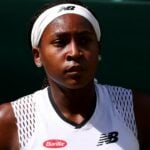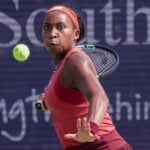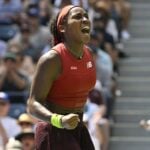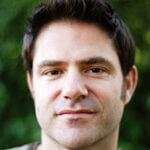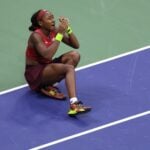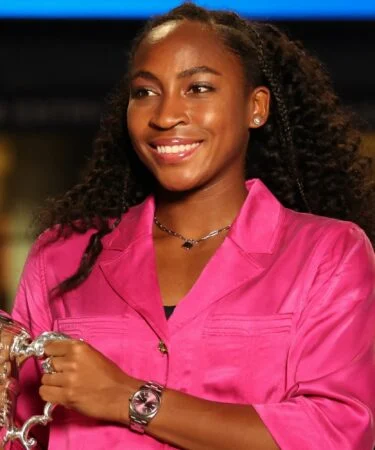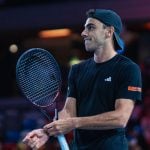How Coco Gauff went from struggling teen to Grand Slam champion in one remarkable summer
From lost at sea to shining under the bright lights – here’s how Coco Gauff and her team engineered a remarkable 180 this summer in America, and why she had it in her all along.
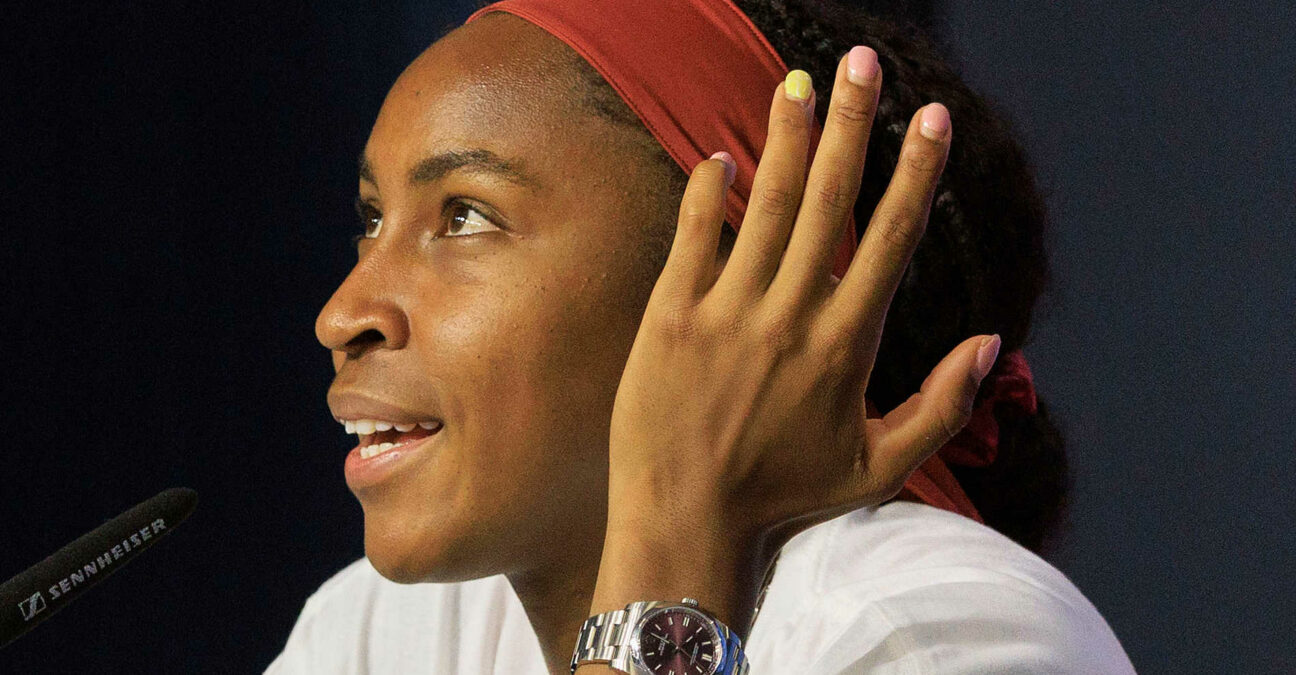 Coco Gauff, US Open 2023 | © Zuma / Panoramic
Coco Gauff, US Open 2023 | © Zuma / Panoramic
Smiling from ear-to-ear and decked out in a stunning yellow sundress that screamed “I don’t want summer to end!“19-year-old wunderkind Coco Gauff went on The Today Show in New York City to tell the world her feelings on becoming a Grand Slam champion:
“It doesn’t feel real at all,” said the newly minted US Open champ.
But it was real. Two days prior, the teenager had gutted out a three-set victory over Aryna Sabalenka in the women’s singles final in Flushing Meadows to become the youngest American to win the US Open since legendary Serena Williams in 1999.
A total of 24,000 screaming fans inside Arthur Ashe Stadium confirmed the fact: Coco Gauff has well and truly arrived.
Perhaps the dress was appropriate. Maybe the rest of Gauff’s career will be an endless summer, one that includes many Grand Slam titles, weeks at No 1 and an ever-growing influence on tennis’ next generation.
But how did she get there?
Yes, Gauff has been a rising talent since she hit the Grand Slam scene in 2015 with a run to Wimbledon’s week two as a 15-year-old – beating Venus Williams in round one – but it wasn’t very long ago that the Florida native was mired in a crisis of confidence, with a forehand that was dragging her down and no full-time coach.
That was April – and May, June and July: a period that was marked by growing doubt in Gauff’s mind and constant criticism from the tennis cognoscenti.
This is September, a time for Gauff to bask in the glory of one of the greatest mid-season turnarounds in recent history, and a chance for us to look back on the key moments that set her up to thrive…

April: Moyano Departs
The season actually started well for Gauff, who opened the year by winning her first eight matches. She picked up her third career title in Auckland before losing in the round of 16 to Jelena Ostapenko at the Australian Open.
There was then a quarter-final in Doha (loss to Kudermetova), a semi-final in Dubai (loss to Swiatek) , a quarter-final at Indian Wells (loss to Sabalenka) and a second-round exit in Miami (loss to Potapova). Though the results weren’t horrible, the general trend was disturbing; Gauff was too defensive, shaky on the forehand, and getting hit off the court by elite players.
In April, when longtime coach Diego Moyano announced his departure from Team Coco, Gauff said: “It wasn’t really my decision.”
That was a time for alarm bells, says coach Patrick Mouratoglou, who has done extensive work with Gauff during her junior and professional career.
“In March, she was without a coach and was a bit lost” said Mouratoglou to Tennis Majors, which he co-founded. She was far from her best level…”
As the losses mounted, the confidence sagged. Gauff could use her natural talent to defeat lesser-ranked players, but her body language dipped, as did her aggressiveness, against the tour’s elite.
By Roland-Garros, where she reached the quarter-finals before being shellacked by eventual champion Swiatek, Gauff had lost seven straight matches against the top 10.
June: Pere Riba enters the chat
Before Wimbledon, Gauff finally found the coach she was looking for: Pere Riba, the Spaniard who had recently parted ways with Zheng Qinwen after a very successful year with the rising Chinese.
Riba was instantly impressed by Coco’s potential.
“I saw in her many things that she can improve, and then when this opportunity arrived I had no doubts that she is the right player, I really believe that I can help her with her game, and with all the things that we are working on, with the footwork and the forehand and the mental side.
“I was so excited and I was really motivated for the opportunity.”
Riba travelled with Gauff to Wimbledon, where the result was one of her most disappointing losses of the season, 6-4, 4-6, 6-2 to 2020 Australian Open champion Sofia Kenin.
“We started on June 23,” Riba told Tennis Majors. “Three days before Eastbourne, and the first two weeks were weeks before a Grand Slam, we could not do too much…”
The Wimbledon loss was tough to stomach, but the pair didn’t panic, and the will to problem solve was strong in Gauff’s camp.
August: American hard courts, and Brad Gilbert enters the chat
Maybe the vibes were better, but there was still more work to be done for Gauff as the North American hard court swing approached.
In her mind, Gauff, was lacking confidence in her forehand, and she admitted that she was already imagining an off-season where she could have time start to implement some larger technical changes in her game.
Enter Brad Gilbert, the legendary American coach who had previously engineered quick reversals of fortune in the careers of Andre Agassi and Andy Roddick.
Gilbert didn’t think Gauff had to wait until the end of the season and he made her believe that she had the tools to win now. Sure, she had plenty of room for improvement, he told her, but he stressed to the teen that her game was good enough to beat anyone – and she believed it.
Gilbert joined Team Coco as a consultant two days before the Mubadala Citi Open in Washington, D.C., and instantly there was a change in tone.
“I started on the fly,” Gilbert said. “We started two days before Washington, so it’s not like we’re doing anything technical, it’s about how we can maximise the moment.”
Gauff captured the title in D.C. and headed to Cincinnati, her team firmly in place and vibing off the positive energy, feeling like a different player.
Scouts Honour
Gilbert is a self-confessed lover of scouting opponents and Gauff was more than happy to get detailed reports on her opponents, which allowed her to play with more clarity.
“The scouting, I think it’s incredible,” Gauff said in New York. “He knows basically every player, probably just from commentating, knows how to play them. I think the scouting reports are quite accurate.”
Gilbert told Tennis Majors that scouting is the thing he has missed the most while away from coaching.
“It’s been fun doing this, I’m thankful to them for the opportunity, but I think for me, the thing that I miss most, by far, of anything – and you don’t realise it until you are back in the mix – is the simple art of scouting,” he said. “I feel like that is the strength in my coaching. There’s all this analytics, Hawk-Eye and everything, but I trust my eyes watching the match before, or watching practice, just watching. I actually use that more than any other information.”
In reality, the Gauff that won the US Open is not very different from the player that struggled so miserably in the spring. Riba and Gilbert helped boost Gauff’s confidence and made subtle changes to her tactical approach, but more importantly, they reminded her that she already had all the tools to be great.
Mouratoglou, who has spent many years working with Gauff at his academy in the south of France, and coached her during all the clay season to rebuild confidence, agrees.
“In just a few months, she went from this to winning her first Grand Slam title, so that is pretty fast,” the coach said, adding: “the key element was for her to come back to relying on her strengths, because Coco has elements that are really exceptional.
“Her defensive game, her movement, her backhand, her fighting spirit, those things are outstanding. But when you lose, you lose even your strengths, they are not as big. I think one of the key elements was to come back to believing in the most important elements of her game.
“When you start to win matches, everything comes back together. I think that’s exactly what happened.”
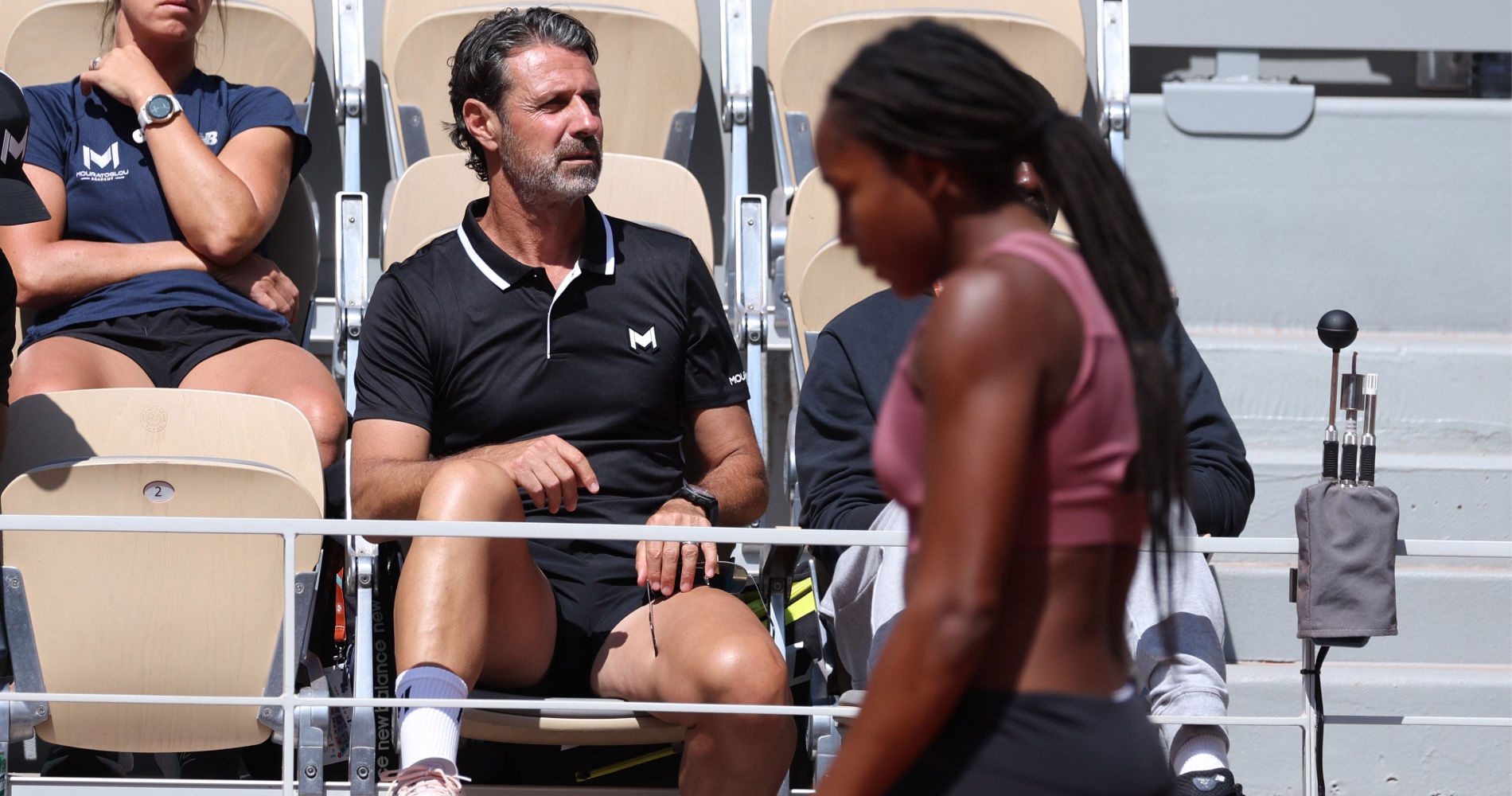
Changes were philosophical and a bit technical, but not drastic
Though the emphasis was on helping Gauff regain her confidence with her game – and tools – there were some subtle changes implemented by the new coaching staff.
“No big changes, but I remember when I started with her people were talking a lot: ‘You have to change this, you have to change that’,” Riba said. “People are talking that coaches are helping Coco improve, but the truth is that Coco is really good and she is so clever and understands really quickly the message we give. She is making progress so fast because she is really good. If it’s another player maybe it doesn’t happen.”
Riba spent time dialing in the American’s footwork, and helping her attack the ball from more aggressive positions.
“Coco is a great athlete, nobody doubts that,” Riba said. “But now, the way she understands how to play without the ball, after the shot, how to move more efficiently on court. Also she has a very good eye, and now she is connecting all these things and now the mobility on court.”

For Coco, sky is the limit
“In my perception, Coco hasn’t touched the sky,” Riba said. “She still has margin to improve.”
Riba says that Gauff can play bigger and use the pace that she generates on serve to make her life easier.
“She has a big potential, she has a lot of power, with the first serve, to be more aggressive, to dictate,” he said. “Coco has the potential to play like ATP guys are doing. With the serve she has to be aggressive because she can do it – not everyone can do it, but she can do it.”
Look at how much Carlos Alcaraz thinks about and works on getting better.
Brad Gilbert
Gilbert believes that all players are not competing against others, but against themselves. He helped Gauff look in the mirror and simply enjoy the evolution of her game, rather than worry about results.
For Gilbert, evolution is the solution.
“That’s an obvious question for every player,” he said. “That’s what all coaches should think about, the constant evolution. The coach wants to get better, the player wants to get better, and at 19 there’s not one shot that you would say ‘Wow, I think that my shot is set’. Look at how much Carlos Alcaraz thinks about and works on getting better. That’s the beauty of tennis – you compete against yourself to get better. That’s your competition.”
Teamwork makes the dream work
Another key ingredient to Gauff’s success has been the willingness of Riba to share the spotlight with Gilbert. When he took the job in June, he probably didn’t envisage a team with a legendary coach as a “consultant”, but he is a true student of the game and he has embraced the opportunity to learn from Gilbert.
It’s all about Coco, after all, he said.

“The most important thing is not about me or about Brad, the most important thing is that Coco believes in the work that we are doing, that she is improving,” Riba said. “Of course he can bring to us many things. I see it as really positive, and the connection with him is so good.
“I am a guy that is always trying to learn from everyone and trying to take the best things from all the coaches. Brad is a top coach, I’m just learning from him and all the time I’m open. I’m so happy that he’s there. When I see Coco happy, I’m happy, and I see it so positively.”
“She’s not going to stop at one”
Andy Roddick, who was coached by Gilbert when he became the last American man to win a major singles title at the 2003 US Open, believes that we are witnessing the tip of the iceberg with Gauff.
“The difference is that she’s not going to stop at one,” he said. “There are dominant forces in women’s tennis, but I don’t think three players are going to win 66 of the next however many slams, so there’s a much better runway for her.”
Roddick believes that the women’s game will not have a dominant force, but instead many players that can rack up multiple major titles.
“With different women’s winners at the four slams this year, there’s an intriguing level of parity,” he said. “It seems to be building towards men’s tennis in the 80s, where you had a bunch of players with the potential to win a handful rather than everything resting on one or two people.”

